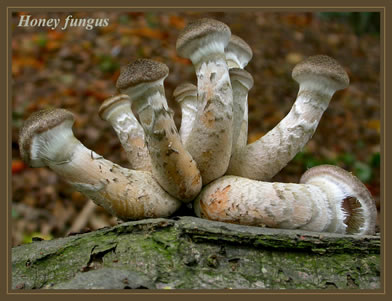FUNGAL FRIENDS GROUP NEWS |
(Member of the Fungus Conservation Trust - Registered Charity No. 1118651) |
ID WORKSHOP |
4. Armillaria - it should be easier than this Honey At one time not so long ago finding a specimen of Honey Fungus and proclaiming it to be Armillaria mellea was more than a little common on all guided forays around the country. Now we know different and we have quite a few species to consider before christening the located fruiting body. With a little time and practice however the identification process gets easier and a few of the species recorded in the UK may no longer pose a problem to the amateur forayer.
Of course its Honey Fungus - but which one The first immediate question that should be asked is does the fruiting body have an annulus (ring on the stem)? If the answer is 'no' then you are certain to have Armillaria tabescens in your hands. Located mainly in South-East England and usually growing in clusters this species is often found in association with Oak (Quercus) and lacks any rhizomorphs (cord-like growths found at the base of the stem, similar in fact to plant roots). A. tabescens has a strong taste and smell and is one of the lesser substantial types of Honey Fungus. The cap is yellowish to tawny buff in colour with a covering of dark reddish-brown scales especially towards the centre. Due to the caespitose (growing in clumps/tufts) nature of this species the stem is often tapered towards the base. The next species under scrutiny is Armillaria gallica which has a tendency to grow alone or in loose clumps thus allowing for the species' most characteristic feature, the swollen, bulbous stem base, hence its previous name Armillaria bulbosa. The annulus on the stem is whitish-yellow and rather ephemeral with a general cortinaceous appearance. The base of the stem occasionally discolours yellow which may link in towards another synonym Armillaria lutea and also black rhizomorphs will be found directly attached to the fruiting bodies. The cap of this species is tawny-pinkish brown with a covering of fine yellowish hairs and usually remnants of the partial veil can be found around the margin. Armillaria mellea is the classic Honey Fungus and as previously mentioned the one many of us thought we knew so well. Identification it seems was a tricky thing but alas if one has access to a microscope then a quick shuftie at the basidia and all will be revealed. Armillaria mellea lacks basidia clamps unlike any other British species and so a 100% ID (if such a thing exists) can be made. Basidial clamps are special septal structures only found in the basidiomycetes group. Without getting too technical you are basically on the look out for a curved hyphal outgrowth at the base of the basidia adjacent to a cross septa division. The cap of Armillaria mellea is variable in colour usually more yellowish than other species with few darker scales arranged towards the centre. The stem is tough and tapering with a persistent ring and becoming paler towards the apex. Just to add there is a slender form of this species so be careful. Armillaria ostoyae is the 4th species we are looking at and perhaps the most awkward to identify. One of the obvious features is the brown underside to the quite well developed ring (cogwheel-like in appearance) however this colouring isn't always present so several other features need to be considered. The cap is brownish with fairly prominent scales, the gills are whitish acquiring pinkish brown blotches and the stem can be robust to slender with a slightly tapering base where yellowish mycelium can be found attached to black rhizomorphs. Found more often than not on coniferous wood this is the trickiest species in the mix so far and needs careful consideration before naming. Microscopically the basidia are clamped at the base. Armillaria ectypa is the fifth member of the Honey cluster and in fact is the rarest. The best way to identify this species is primarily on habitat. If you find an Armillaria type specimen growing in a moorland/peaty area amongst mosses then most definitely use this species as a starting point. Growing singly or in clusters with creamy-pink gills that are adnate to decurrent and without ring or bootlaces this would be a very exciting find for the most ardent myco fan. The hygrophanous cap is striate at the edge and with a scaly centre. Armillaria borealis and Armillaria cepistipes are two species that are generally found in Scotland with the former having no prominent scales on the umbonate cap and most usually found high up the trunk of trees of the Betula genus. This species has a striate margin to the cap as does Armillaria cepistipes with the latter turning yellow then brown when bruised and usually located at the base of deciduous trees that have been weakened by another pathogen. These latter two species are the trickiest of the lot to identify and a studious approach during the ID procedure needs to be taken if any specimens are suspected of being found. To finish this short piece here are a few facts about the Armillaria group as a whole that may trigger you into studying these destructive 'shrooms even further./ * Armillaria may live for decades in coarse woody material. * Armillaria causes a white rot of infected wood. * If fruiting bodies are absent then die back, poor growth or general yellowing in the crown or lower branches may signify the presence of Armillaria. * The rhizomorphs' growth and ability to penetrate roots are dependent upon the specific fungus, food sources available, the soil and the host species being attacked. * In 2006 Armillaria ostoyae was proclaimed the largest living organism on earth. Covering 2,200 acres, with a 3.5 mile outline and estimated to have been growing 2,400 years this is one special fungus.
|
